ACING the OPI in SPANISH

A quick introduction
The Oral Proficiency Interview, or OPI / OPIc, is a language competency certification recognized by the Interagency Language Roundtable (ILR) of the U.S. Government for determining the level of conversational ability of a candidate in any given foreign language. The OPI was developed by the American Council on the Teaching of Foreign Languages (ACTFL) in conjunction with the ILR. It is administered by a specialist private testing company, called Language Testing International (LTI), with the help of proctor institutions around the world (and I am proud to be an official proctor myself).

The classic Oral Proficiency Interview originated as a live, 20-30 minute telephone or Skype-style conversation between a certified tester and the candidate. Thanks to advances in IT, one can now do the modern version, called the OPIc, which is the same test but computerized. This means that the candidate engages online with an on-screen avatar that asks the prompt questions, rather than with a live interviewer.
For an excellent demo of the OPIc, please go to: https://opicdemo.actfltesting.org/ – you should really make time to review this demo, which closely resembles the actual exam. An important note when looking at this demo – it is for doing the OPIc English-language competency test. However, just as in this demo for the English, please note that also in the case of doing the Spanish OPIc test, the initial list of options establishing your profile of personal interests will be put to you in English, making things a lot easier for you than the equivalent European exams that jump straight into Spanish exam questions (as will be explained later).
The system of tests commonly referred to as the OPI isn’t limited to testing just your oral expression. Going beyond oral proficiency, candidates can also test their listening proficiency with the LPT, their reading proficiency with the RPT and their competency at writing with the WPT. Together, these four certifications therefore cover the same ground as the European language exams such as the DELE / SIELE of the Instituto Cervantes (The OPIc is equal to the SIELE S4 “oral expression” unit).
Your certificate for any of the four competencies can, at your election, be issued either in terms of the USA-ILR scale (0>5) or in terms of the European scale (A1, A2, B1, B2, C1) because these exams share the same policy foundation, norms and standards, namely the CEFR – the Common European Framework of Reference for Languages.
The OPI in its live as well as computer formats is a test that reliably measures how well a person converses in a foreign language. It is focused on the communicative competency – in other words, on the clarity of the message. The procedures for both the OPI and OPIc are standardized; the tests assess speaking ability globally, in a holistic manner, determining strengths and weaknesses (see this blogpost for how OPI compares to DELE / SIELE: https://delehelp.org/oral-proficiency-interview-vs-dele-diploma/

The primary goal of the OPI / OPIc, from the system’s perspective, is for the tester to engage constructively with the candidate, in such a way that a proper sample of speech can be obtained from the candidate. It isn’t, therefore, a “Spanish inquisition” trying to catch you out. After all, from the perspective of the examiners, they must – first and foremost – capture a sample of your speech that will be sufficient to allow a valid rating of your competency. To achieve that, the conversation must clearly demonstrate the highest sustained level of performance of the speaker (known as the “floor”) plus the level at which the speaker can no longer sustain the performance (known as the “ceiling”), over a variety of topics.
The OPI resembles a conversation – but, in fact, the live tester as well as the OPIc’s avatar “Ava” do respect a strict protocol to put the candidate at ease; they use trigger questions that conform to the candidate’s own pre-stated interests, to get the candidate to speak up.
The OPIc – personalized for YOUR interests
The preliminary phase of the OPIc that you will go through on exam day setting up your interview, illustrates this point well. This initial phase establishes your “interest profile” and aims to ensure that the later conversation will be geared towards topics that you will be at ease to talk about. Getting this selection of questions right on the part of the OPIc system should ensure a substantial enough sample being recorded. After all, there’s no point in asking you questions that you can’t answer because you know nothing about a particular topic and have no interest in it. Doing that will simply mean that the system has failed to meet its own primary need, which is to get from you a proper representative sample that can be assessed.
The system’s data bank contains a multitude of possible exam questions, covering a hugely diverse field of interests and activities. Initially, therefore, the computer will list for you options (in English) about your personal interests across a very wide range of subjects, including hobbies, sport, vacation preferences and the like. The fact that the OPIc is designed this way, allows you as English-speaking student a clear comparative advantage when you do the OPIc, as compared to the DELE or SIELE exam – firstly, because the OPIc asks you these initial questions in your own mother tongue, and secondly because it sets out to personalize your exam according to your own personal interests, whilst the DELE /SIELE simply launches straight into an undifferentiated set of exam questions, in Spanish from the word go, in a “one size fits all” style.
Your responses to the OPIc’s personal profile options then determine the precise exam questions that the computer will select for you, and which its on-screen avatar – named Ava – will then put to you (in Spanish) during the actual test. This is what the screen will look like, that you will be speaking to when doing the OPIc (in the case of the classic telephone-based OPI, your interviewer will also first establish your broad interests, but obviously it cannot be as detailed as the technology allows for the OPIc):
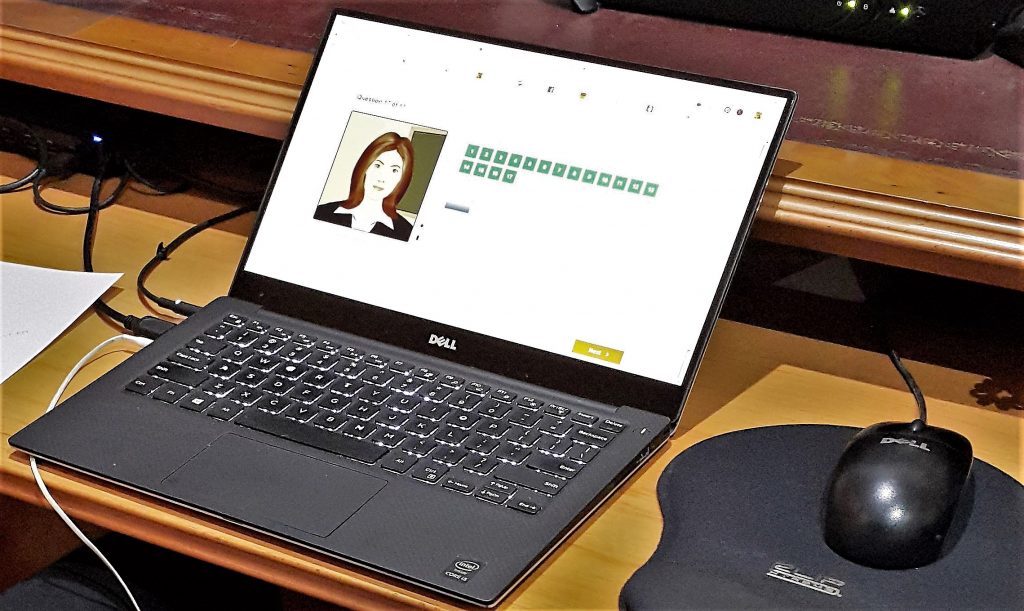
Next we will show you some further screen shots, to give you an idea of how detailed the questions are during the set-up “profile phase” (remember, you can see the official demo by clicking on the link supplied earlier above: https://opicdemo.actfltesting.org/ ).
The OPIc system will first ask you to identify general fields of personal interest, which you would like to talk about. The next screen shot contains just a small sample of the areas of interest – for example, it will ask you about your activities, hobbies, sport and vacation preferences. Under sport and physical activities, for example, you will find a list that contains basketball, baseball/softball, soccer, football, rugby, ice hockey, field hockey, cricket, golf, volleyball, tennis, badminton, table tennis, swimming, biking, motorcycling, scuba/snorkel, ski/snowboard, waterski… And so the list goes on (it is therefore quite unlikely that you, no matter which part of the world you’re from, won’t find subject matter in there that you would be comfortable and knowledgeable to talk about). Here’s the initial “background survey” screen shot :
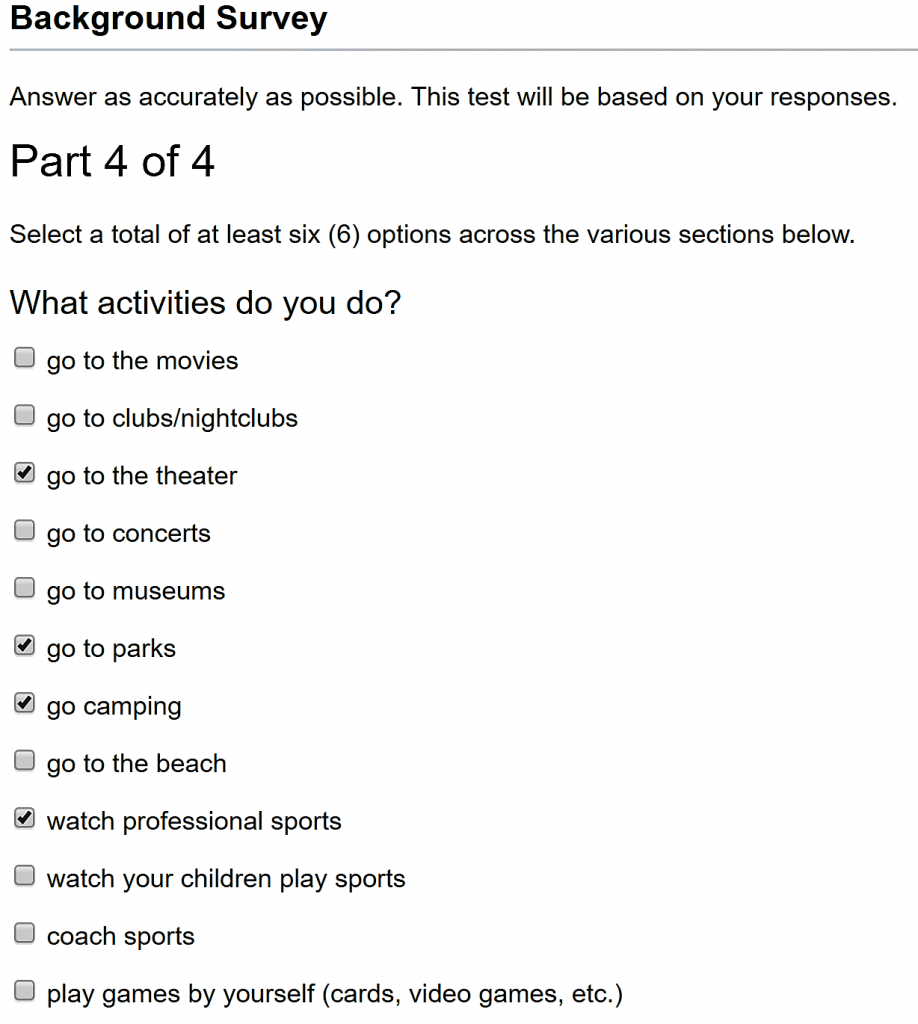
The next screen shots show some of the hobbies plus sport options not yet listed in the text of the previous paragraph, as well as vacation options, to further illustrate the level of detail and personalization sought:
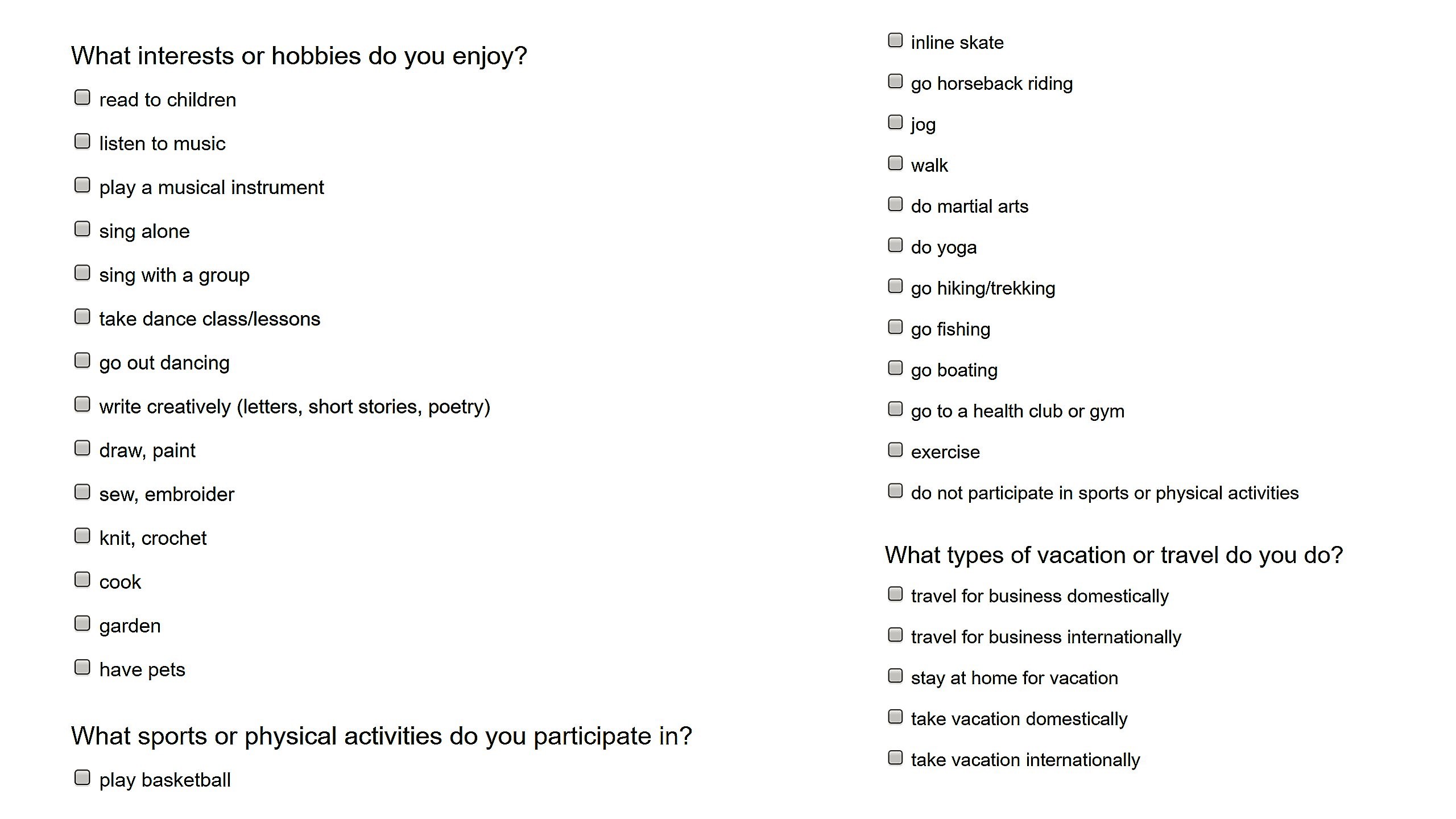
The OPIc will next ask you to broadly assess your own level of Spanish-speaking ability. This serves to ensure that the computer avatar asks you questions that correspond, in degree of difficulty, with your level and don’t totally overshoot or under-estimate it. This is again a great advantage of the OPIc over the SIELE, since the latter does not first establish a personalized profile and thus needs to incorporate into each test segment the full spectrum of difficulty levels ranging from A1 beginner to C1 advanced, which all candidates then willy-nilly need to work through. (In this particular screen shot you will see that the OPIc system asks about your “English-speaking” ability; in your exam it will of course be your Spanish-speaking ability, but the initial profile questions will still be asked of you in English):
The OPIc – personalized for YOUR level
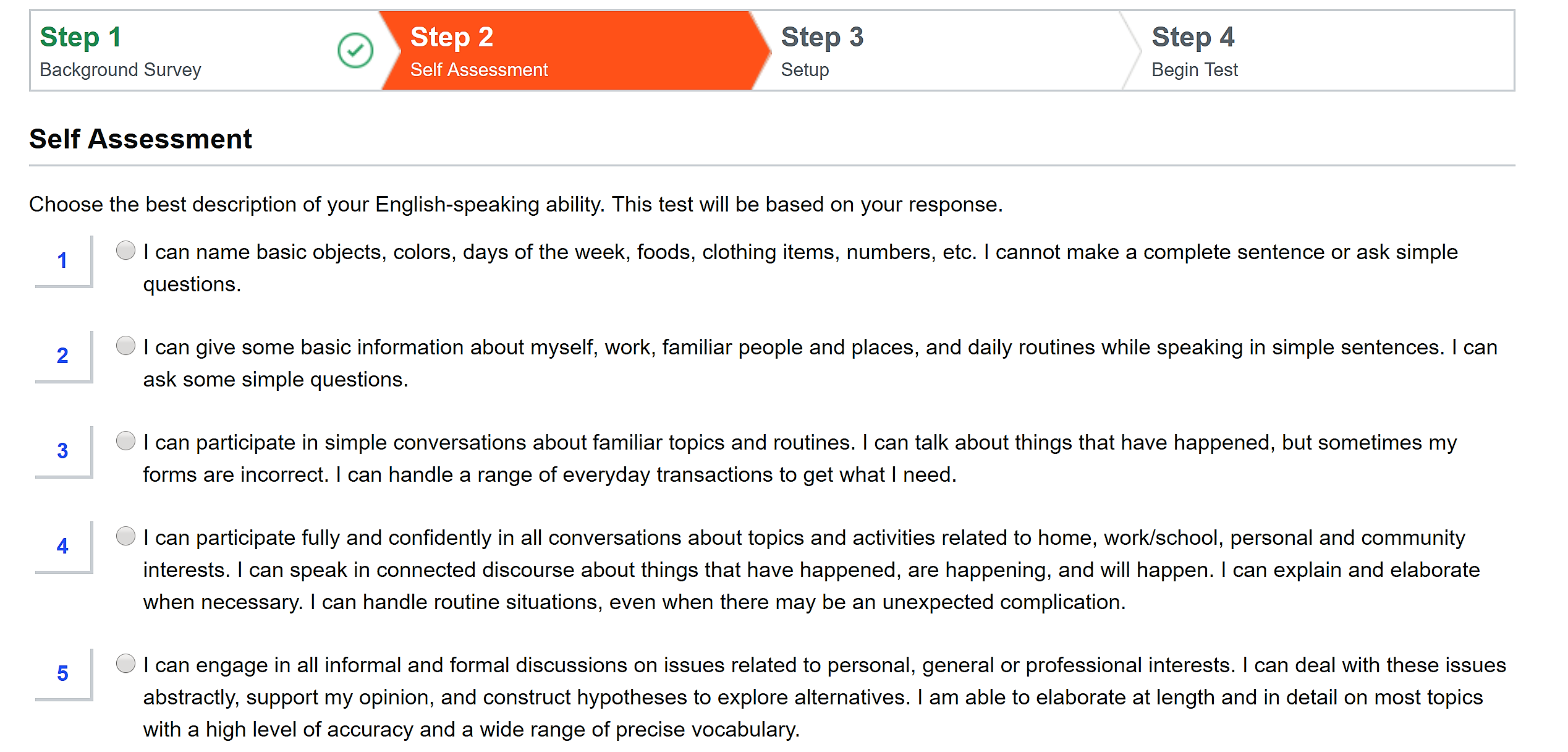
The OPIc system is technologically very robust and glitch-free. We here at DELEhelp are both SIELE exam admisitrators as well as OPI proctors, and in our experience the online capacities of the OPIc definitely set the gold standard for maintaining you connected on-line during the exam. You are, therefore, very unlikely to be left stranded in the middle of the exam because of some technical glitch, if you select to do the OPIc. It is also a very user-friendly and intuitive system, and I can truly state that LTI (who manages the system on behalf of the ACTFL) are always extremely helpful and quick to respond to any queries. You therefore don’t need to be a computer genius in order to be able to use the OPIc system with ease and confidence. Remember also that there’s always an OPI proctor present, who will step in if any technical issues should arise during the test.
Contrary to what one may imagine, OPIc candidates find it easy to interact with AVA the avatar. She speaks / articulates very clearly in Spanish, not too fast, and without some deviant accent. Electing to do the OPIc instead of the old-style OPI, also eliminates any possible issue of human bias or quirks of speech / accent on the part of the human OPI interviewer that you may end up with.
NB: some institutions still require that their applicants/employees must take the test in the form of the classic OPI, not the OPIc, so you need to inquire and establish from your employer or the entity to which you may be applying, what their rules are about perhaps insisting on one format and not the other. In truth, the standards are exactly equal and the certification equally trustworthy, and it is no secret that we as proctors much prefer candidates to do the modern OPIc, because of all its obvious advantages for both the student and the administrator.
The system is also mindful of helping the student to keep track of time elapsed / time remaining for responding, as well as to keep you orientated with regard to where you are (i.e., at which question) i.t.o. the overall test segment. The next screen shot shows what you’ll see while you’re doing the test – there is a bar at the top of the screen that shows you at which question you’re at, and another bar showing you the time remaining for your responses:
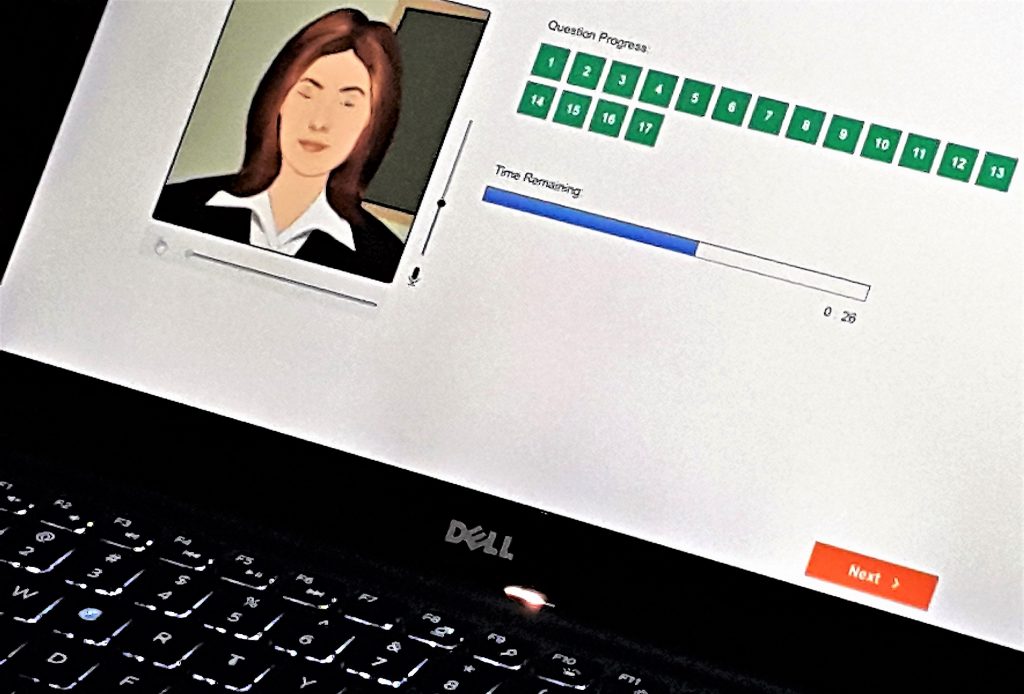
This next shot shows the last screen that you will see, when you’ve finished the OPIc test:
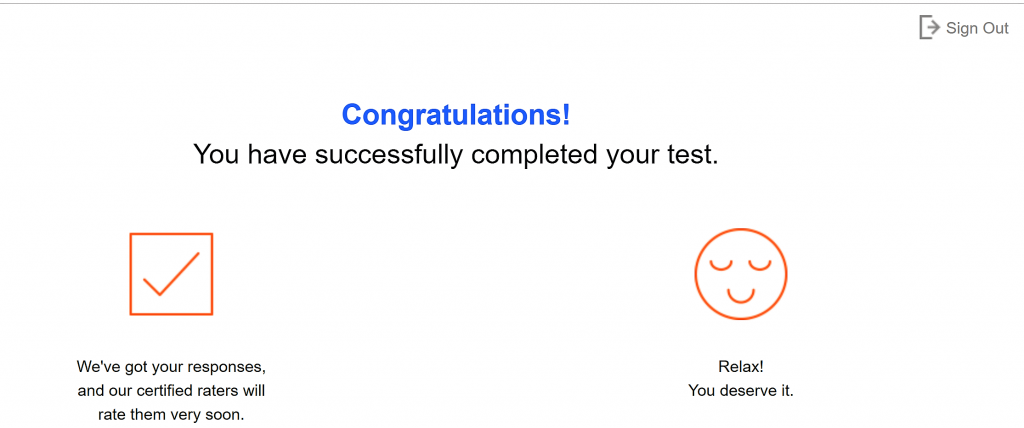
In the next segment we will share with you some tips that underpin doing well in oral exams Keep in mind that the OPI/ OPIc is a multi-level exam. What this means is that, contrary to the DELE exam for example (for which you have to pre-select a specific level that you wish to write) your result is not going to be simply either a pass or a fail for that particular level. Unlike the DELE, you effectively cannot fail the OPI, because the goal of the system is to place you along a competence curve, corresponding to the level you have actually demonstrated. If you have asked for an OPI/OPIc certificate expressed i.t.o. the European system, you will for example get a certificate stating that your oral expression competency in Spanish is at level A2, or B2, or C1 or whatever the case may be.
In the case of the DELE, if you haven’t made the grade i.t.o. the specific level you have enrolled for – say B2 – you don’t get an A2 or B1: you simply get a No APTO, meaning fail, with nothing more to show for your entire effort. (The OPI/OPIc is, as multi-level exam, therefore similar to the multi-level SIELE, which is the modern online version of the DELE introduced by the Instituto Cervantes of Spain in 2016.
What the OPIc certificate looks like
In the next image you can see what an OPIc certificate actually looks like. In this example, the grading was done i.t.o. the ACTFL system, with the candidate achieving an “Advanced Low” which corresponds to a B2 in the European system. You can see that what the grading means in practical terms (i.e., level of communicative competency) is explained on the back of each certificate:
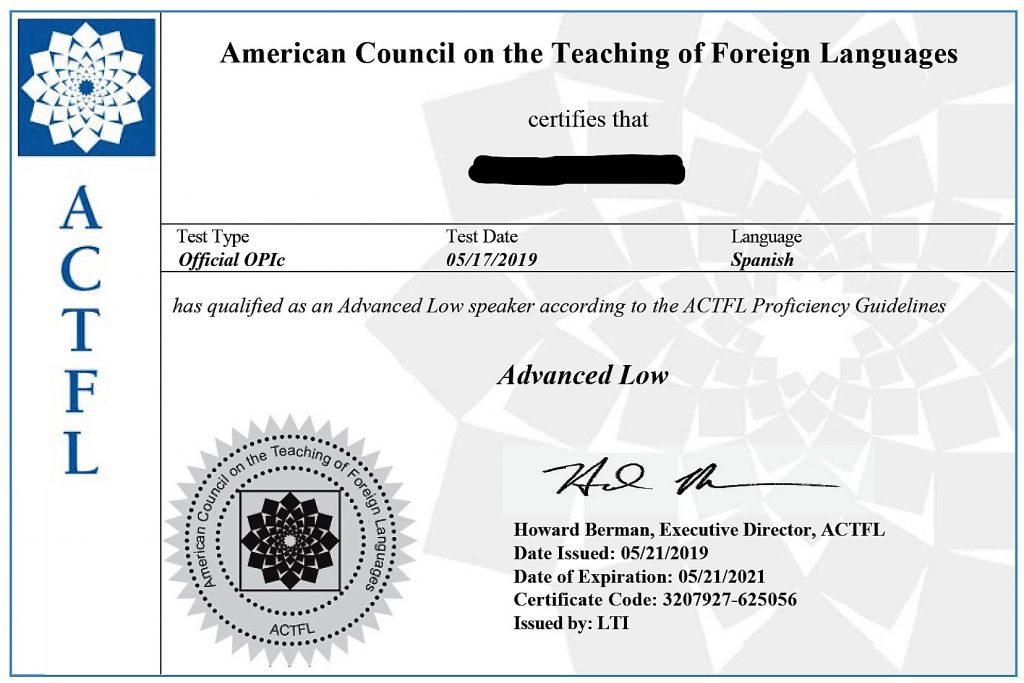
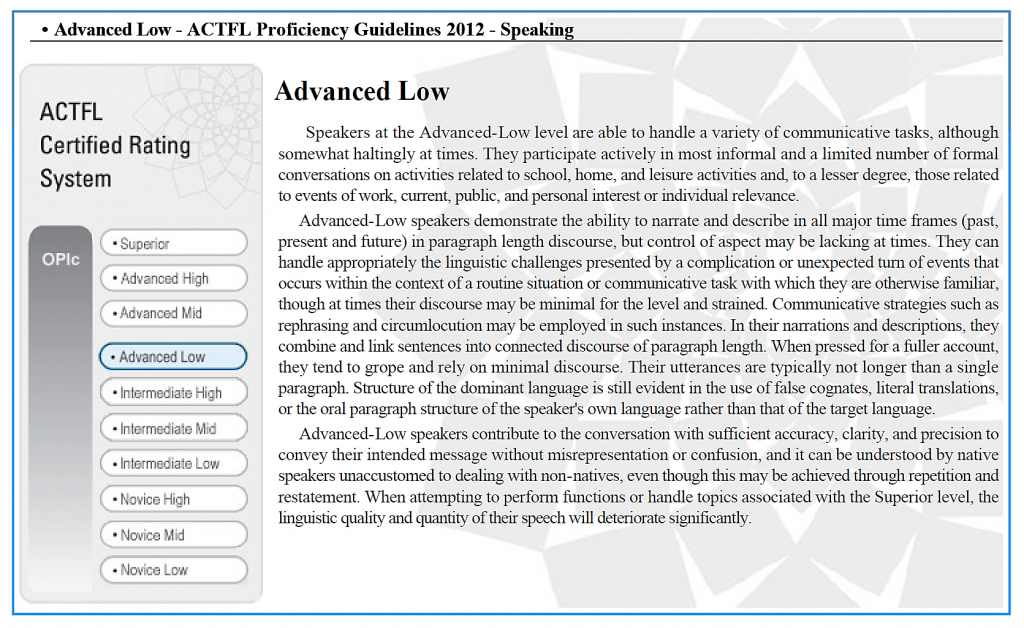
Basic tips for Acing Oral exams:
- Know what the goals are of the OPI/OPIc. It is an examination of your ability to communicate orally in everyday situations. There isn’t a more common, nor is there a more essential way of communicating, than by means of speaking. This makes the oral interview obviously crucial in assessing your overall communication competency.
- Know what the official OPI oral interview format and scoring criteria are. You need to be familiar with the system and criteria that the testers will be using to assess your oral performance. If you don’t know this, you won’t know how best to converse with your interviewer.
- Sit correctly: When sitting down, don’t slouch (i.e., don’t sit with your head and upper torso leaning back in relation to your backside, because this posture constricts your breathing). Sitting correctly means getting your lower backside as far back into and pressed up against the chair’s backrest as possible. This will help with your breathing and articulation. It will also force your upper body forward, thus into a natural posture of engaging positively with your interlocutor (this remains valid, also for the OPI format, which is an interview by phone or – in the case of the OPIc – engaging with a computer avatar).
- NB: NB: Engage with your interviewer, be relaxed and friendly, COMMUNICATE.
- Fluency is an important scoring criterium; such fluency is achieved particularly by means of using link phrases (connectors), for which the testers will be actively looking in your discourse – it is therefore important to know and practice a list of such phrases which you can employ naturally. In general, it is critical not to get hung up on searching desperately for specific words that may have momentarily abandoned you; use whatever others that come most readily to your tongue at that moment, even if you also have to use additional description to communicate your point.
- Coherence is important. Don’t launch willy-nilly into a torrent of speech, hell-bent on appearing to be answering the question, but without any thought or plan. Communication is more than filling time with sound – true communication is based on transmitting a MEANINGFUL MESSAGE. The typical structure for such is: intro/body of proof/conclusion. Organize your thoughts.
- Linguistic scope is another core aspect tested. What linguistic scope means, is your repertoire – the breadth and command of vocabulary and expressions; how familiar you are with colloquialisms and idiomatic native language use, in order to be able to correctly contextualize sayings and to do justice to communicating about increasingly sophisticated concepts and themes. There are no better ways of improving your Spanish (and thus your score) than extensive and attentive reading, plus jotting down new words on your flashcard system such as www.cram.com . To stay abreast of news actualities across the full spectrum of subjects, spend a few minutes each day with the free site www.practicaespanol.com By attentive reading, we mean that you should be looking up words that you encounter and don’t yet know – include these in your vocabulary flashcard list, and revise them frequently. Here’s a link to a blog-post that will help you with the study of vocabulary: https://delehelp.org/expand-vocabulary-best-dele-exam-prep/
- Accuracy or correctness of language is a scoring factor. This relates to your correct use of fixed idiomatic expressions and grammar, such as agreement of gender and number. Slow down! It’s fine to pause briefly and naturally to gather your thoughts (a good fall-back with which to fill these moments is using connectors or link words, such as entonces, which will give you breathing space and contribute to naturalness and fluency). When you start talking, talk at a slower/measured pace (but clearly conversational) so that you can allow yourself time to formulate thoughts and speak accurately. If you make a mistake, correct yourself in a natural manner, don’t try and ignore it as if it didn’t happen – you will actually be positively assessed for having corrected yourself.
- Confirm questions if needed: It’s certainly normal to get nervous in an exam situation, and equally normal even in real everyday conversations to require clarifications from your interlocutor. Rather ask, than answer a question that you’ve misunderstood. So, make sure to clarify the question if in any doubt, with a phrase like “Puede usted explicarme su pregunta, por favor…” (in case of a telephonic interview).
- Personalize and engage with the content, by reflecting your own perceptions and opinions about the subject matter and quoting relevant personal experiences; don’t just repeat in a purely descriptive manner the elements of the question your tester had posed.
- Pay attention as well to your delivery, i.e. to the art of oratory and rhetorical devices you employ in order to persuade and negotiate: for example, vary your tone and emphasis, to nuance and underscore key points. Be sure to adapt your presentation to the nature of your audience and setting – such adaptability on your side to conform correctly i.t.o. appropriate level of formality of language or sophistication of the lexis / terminology you use, in relation to the demands of the event or setting being simulated, is an assessment criterium, especially at the higher levels. Don’t be so hung up on ensuring correctness of your grammar that you lose the natural flow, rhythm and thrust of conversation as interactive, interpersonal engagement. SMILE (it will reflect in your voice, even though the tester can’t necessarily see it). Remember that the testers are taught to draw you out of your shell, in a friendly manner, and never to correct or criticize you – therefore, relax: they are not your enemies, nor your inquisitors.
- Confidence is truly the key to fluent, engaged communication. Never forget that the OPI tests your capacity to communicate effectively – to receive and transmit meaning. You will be authentic and authoritative when you speak from inner conviction, having personalized your responses, rather than parroting talking points with which you don’t identify. The best booster of confidence is the knowledge that you have practiced and practiced and practiced doing mock versions of these oral interviews, to perfection, before the actual interview date – doing as many guided simulations as possible with your expert tutor via Skype or in situ immersion in the weeks and months leading up to the exam.
- Read out loud whenever you are reading Spanish books, blogs or news media during your self-study and relaxation hours. As preparation and practice of your pronunciation, do as much of your Spanish reading en voz alta, so that you can get accustomed to actually saying words, not just seeing or thinking them.
- Record your practice sessions on tape or preferably on video, when you do simulations of interviews. That way you can hear and see yourself in action and can take note of improvements you need to make. A good method is to review how you initially had responded, and then “re-do” your initial answers in writing, ensuring that they are now to the point, well-structured, accurate and impactful – thereby developing and internalizing your own mental system of organizing your thoughts so that you can respond to questions reflexively in such an organised, clear manner.
- MOST IMPORTANT – get an expert tutor with whom to practice and who can design for you an appropriate personal study plan & help guide you to success.
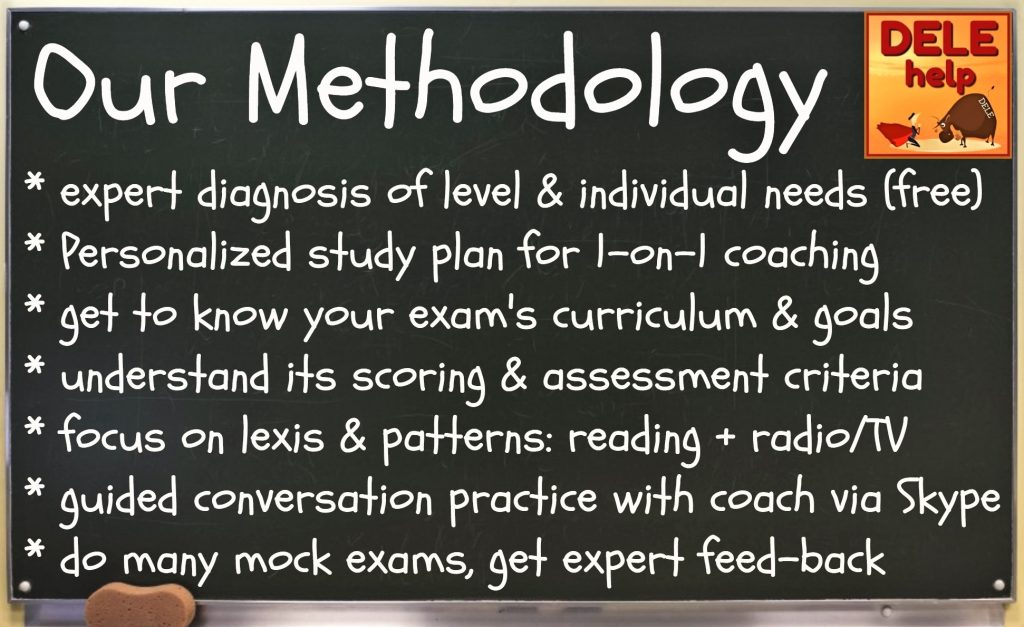
Informative video talks on key exam topics on our YouTube Channel, FREE

FREE OPI Workbook!
This blog post is already quite long. Rather than trying to cover everything here, I prefer to offer you – FREE and with NO OBLIGATION – our in-house DELEhelp Workbook #8. It contains a lot more detail about the OPI grading system, as well as the scoring criteria used by the examiners (the “can do” statements against which your performance will be weighed in relation to the different competency levels).
The Workbook also contains links to videos of actual OPI interviews, as well as to further free resources that will give you even more background detail about the OPI/OPIc. Just click on the image below, to access the short contact form with which to ask for our free Workbook #8. And while asking, you can also request the download links for our other free in-house workbooks as well, as advertised elsewhere in this blog and on our DELEhelp Facebook page.
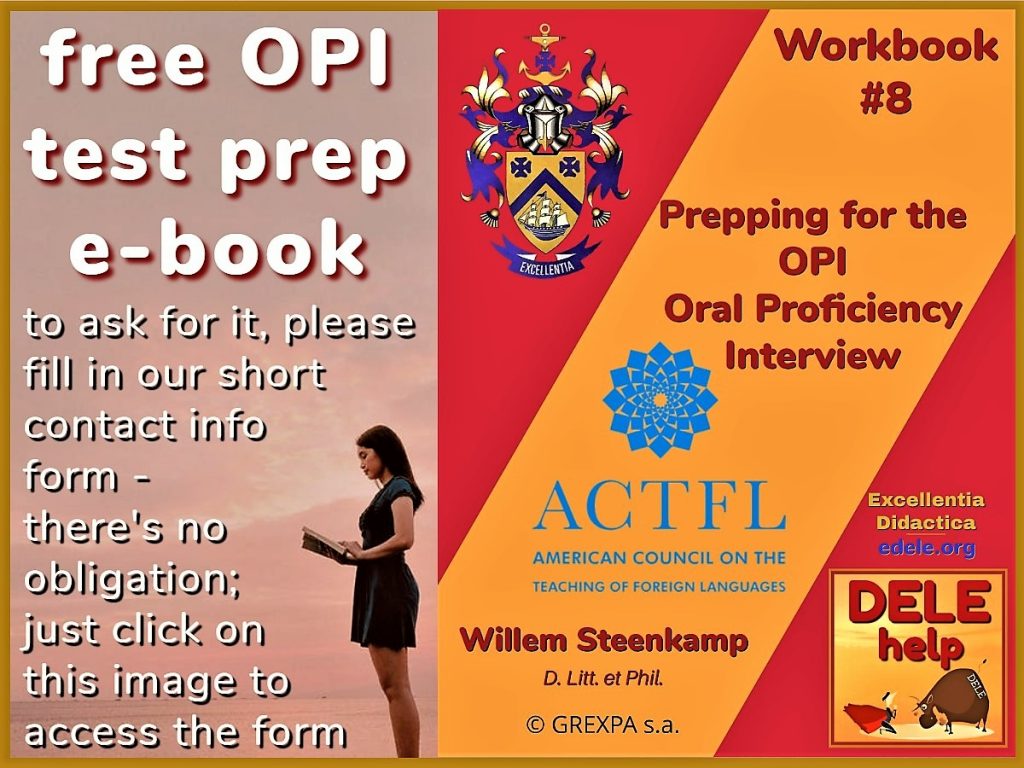
Buena suerte with your preparation for Acing the OPI in Spanish!
Willem



I would like to be familiar with the expectations of the tester to be able to answer the questions with a level of academia and everyday vocabulary.
Hola Hope – I’ve just sent you an e-mail with links for downloading our relevant workbooks; these will provide you with insight into what the testers are looking for (as will our personalised, 1-on-1 online coaching, which is strong on exam simulation conversations). If you don’t immediately see my e-mail, please check your spam filter – it was sent from my Hotmail account: [email protected] Salu2 Willem